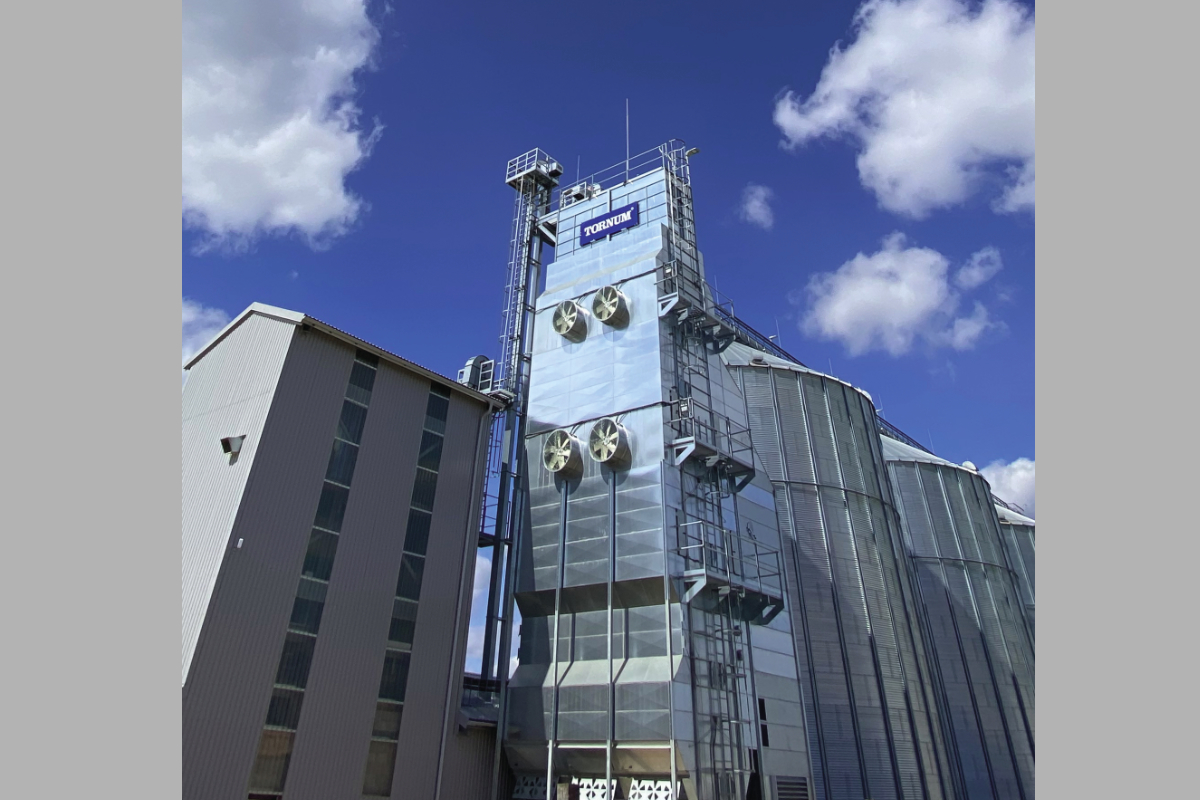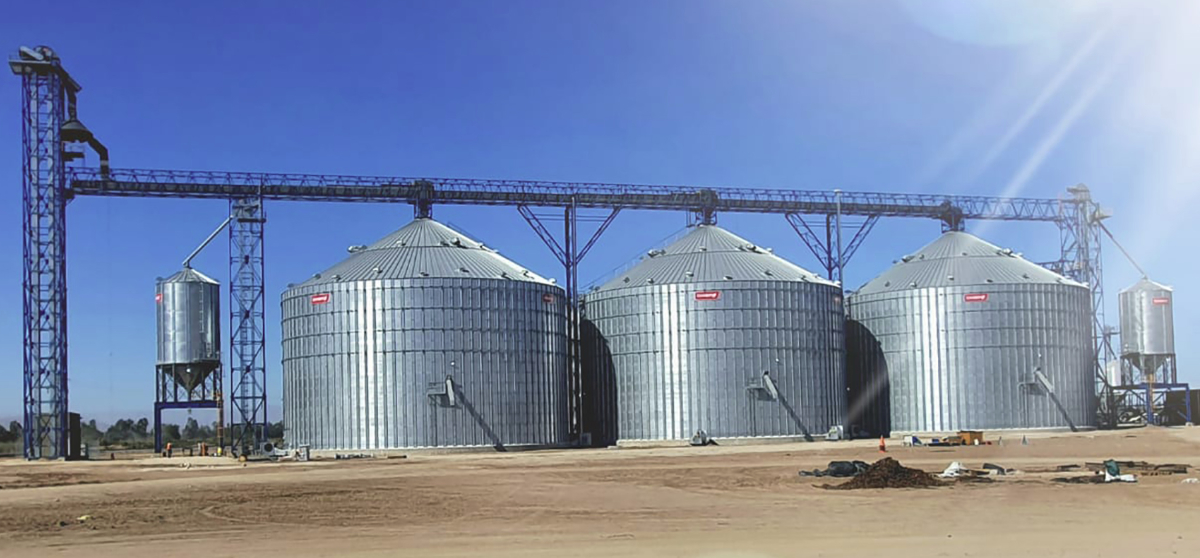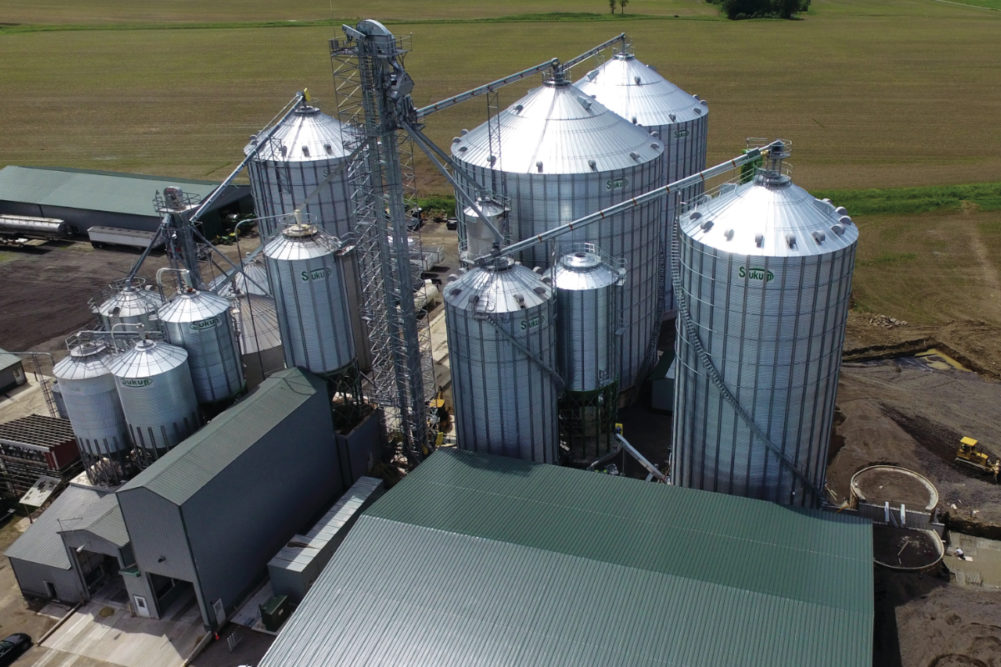While actions taken to curtail the current coronavirus (COVID-19) pandemic may lower demand for new or expanded grain storage and handling facilities in the coming months, equipment suppliers who responded to a recent World Grain survey are optimistic demand will build as the world enters its new normal.
“This COVID situation is a new crisis in the sense it is not similar to those we have faced before: it is not a war, it is not a liquidity crisis, it is not a bank collapse,” one supplier said. “We are foreseeing a V curve with a deep collapse and a quick recovery, at least for the food industry. That would turn into a 25% decrease of sales this year, and hopefully, coming back to a new normality the next year.”
Based on previous crises, one supplier believes there will be a sudden influx of funds to agriculture projects. People will need to cover their basic needs and investment groups will want to bet on safe projects, like the food industry.
“We foresee as well an increase in public-funded projects with the aim of keeping the prices stable and avoiding turmoil and civil unrest,” a supplier said.

Another said new projects are being postponed as customers are paying more attention to keeping existing equipment running as best they can. Another supplier agreed, saying customers will act conservatively from a spending standpoint and ensure equipment is properly maintained.
“They might look at options to repair versus replace a sensor or system for the short term,” the supplier said. “However, newer technologies have benefits that are quite affordable and easy to use. Wireless technologies and software that can be added on to existing systems or replace outdated systems will always be in demand. We have all learned that we need to be flexible in where we can do our jobs, so software that gets inventory data to anyone, anywhere will be a top priority to keep people safe.”
Most say their manufacturing facilities are operational, and all have taken additional sanitation and social distancing protocols to keep employees safe.
“We are continually securing new projects and clients, and we are optimistic to see an increase in opportunities in the second half of the year,” one supplier said.
Along with the fallout from the pandemic, suppliers are feeling the impacts from new trade agreements, tariffs and non-tariff barriers, some of which may be exacerbated by COVID-19.
“Those few countries with non-accessible markets due to special taxes have remained closed for us historically and the situation does not seem to be experiencing a change in the close future,” one supplier said. “If any, the COVID outbreak will encourage protectionism policies in some markets.”
Another supplier noted they have been closely watching commodity pricing, the health of rural communities and the evolution of global supply and demand. There has been stress on the American farming community and US-based companies, they said.
“Our marketing has a global reach, and we are positioned to serve the agricultural community with distributors in many companies throughout the world,” the supplier said.
Customers are demanding more specialized and detailed solutions such as cooling devices or insulation sheets. Additionally, some are storing new crops, or crops that were not widely stored before, such as rapeseed or sorghum.
“New crops always bring challenges for the industry that has to carefully develop accessories for them,” the supplier said.
As grain storage facilities become more integrated with the respective food supply chain, there is a greater call for digitalization and harmonized technology, another supplier said. Wireless communications and remote monitoring are drawing a lot of interest as working from home and social distancing measures are so prevalent.
“Any technology that makes it efficient for a person to do their job remotely or without a lot of interaction is of great interest to companies,” one supplier said.
Customers also want optimized energy consumption in the drying and cleaning process as well as a hygienic design to maximize food safety. Others said customers want better conditioning with more control of the conditioning process as well as better accounting of inputs/outputs by weighing in flow.
“Facilities are making plans for the future,” a supplier said. “There is a lot of research taking place, testing of different technologies, and quoting for budgetary needs. We also see companies gradually rolling out projects incrementally.”
Some of the areas seeing the greatest demand for new construction include Africa, where the population continues to increase. There is a huge need in the region for proper grain facilities that can store grain over time without incurring the huge losses that are currently occurring. The Middle East, Southeast Asia and Eastern Europe also are seeing an uptick in orders.
Popular facility types include flour mills, feed mills and soy processing plants. As the installed base of ship loading and unloading facilities in Asia, Europe and North America come to the end of their lifecycles, there will be a big demand for retrofits and new installations in the coming years, a supplier said.
Here is a look at some of the recently completed grain storage and handling projects around the world.
Reinvigorating rice in the Philippines
Biotech Farms wants to reinvigorate local farming on the Mindanao island in the Philippines with its new paddy-to-rice processing facility. The integrated agro-industrial complex near Koronadal includes a biogas power plant, a corn processing plant, a feed mill, a paddy processing plant, a rice mill and a rice reprocessing facility.
While rice is the main staple food of the Philippines’ 100 million people, the country has struggled to keep pace with the demand. Once a self-sufficient rice producer, the Philippines has become one of the world’s largest rice importers, buying milled rice from Thailand, Vietnam and India. Biotech Farms wants to help change that with its complex along with a plan to support local farmers by increasing their production yield through assistance in farm input, the introduction of farm mechanization and training.
Initial discussions about the project started in 2014 with Bühler, based in Uzwil, Switzerland. Following land preparation and equipment delivery, the project was commissioned in phases between 2018 and 2019. The Biotech complex can receive up to 600 tonnes of paddy per day from local farmers. Wet paddy is cleaned, dried and processed into clean rice.
The process starts with wet paddy transported by truck to the three intake pits that have a capacity of 65 tph. The paddy is then sent by conveyors for a first round of pre-cleaning and then it is stored in temporary bins. Pre-cleaning includes three 25-tph LALA paddy cleaners; two 25-tph SMA cleaners; one 50-tph LACB cleaner; and six wet paddy bins with a capacity of 700 tonnes each.
The wet paddy is transferred to a three-phase continuous drying line to bring down the moisture. Three continuous flow dryers with a capacity of 21.5 tph bring moisture content down from 32% to 13%. For specific varieties available in smaller batches, Biotech Farms also installed a batch drying line from Bühler that was commissioned later in 2019. The line includes five LELA batch dryers with a capacity of 150 tonnes per batch and a moisture content reduction from 28% to 14%.
Upon reaching an optimal moisture level, the paddy is then chilled and stored in large 2,000-tonne bins, waiting to be sent to the rice mill. Connected to the silos through conveyors, Biotech operates a 20-tph rice mill, equipped with Bühler technology at every stage from intake, to cleaning, polishing, whitening, grading and bagging.
The mill features a 2-pass optical sorting system. The first pass in the two Sortex S6 sorters removes color defects while the second pass through the two WV-7 machines rejects chalky rice from the main white rice output.
The rice mill has been built with a special focus on hygienic design and food safety. The mill layout is clearly zoned in order to separate process areas. Areas with high dust concentration (bran, bagging) are separated from areas with low dust concentration (production, packing). The office area is also clearly separated. A visitor walkway also has been set up to allow visitors to pass through the floors without disrupting or contaminating production.
Next to the rice mill, Biotech Farms built a reprocessing mill, which aims to improve and add value to the milled rice of local farmers.
The white rice processing lines end with automatic bagging lines, also by Bühler, that include two lines for 20- to 50-kg bags and two lines for 2- to 10-kg bags. The final product is then put onto trucks and sent across the island to be sold through a network of malls, rice wholesalers and retailers.
A unique feature of the complex is that it was built as a self-reliant and sustainable loop, which generates savings for Biotech Farms and ensures a more reliable and sustainable operation. It has been designed to recover as much waste as possible for renewable energy production.
Rice husks, which are waste from the milling process, are sent through pneumatic tubes to be incinerated in the biomass power plant. The biomass plant features a Vyncke furnace, generating hot thermal oil for the production of electricity using an Organic Rankine Cycle (ORC) Turbine-generator. Hot water is produced from the ORC Turbine-generator as well as from the waste heat of the furnace.
The 13.2kV electrical installation across the full complex, engineered and commissioned by Bühler’s sister company Bühler+Scherler, draws all its needed electricity from the biomass powerplant with excess electricity exported to the local utility grid.

Sudan adds major storage
The Sudanese government recently completed a 100,000-tonne storage plant in Barakat City, Sudan. CTS Makina was the contractor for the project, which is one of the largest facilities of its kind in the nation.
Symaga, based in Villarta De San Juan, Spain, supplied 20 SBH1834/19 silos with storage capacity of 5,000 tonnes each along with accessories. The facility handles wheat, sorghum, corn and soybeans.
Symaga said it has worked with CTS on several other projects in countries around the world with great success.
Webcor adds storage in Angola
Webcor Group, one of Africa’s leading players in the agricultural commodities and fast-moving consumer goods business line, is in the final phase of constructing a grain storage project in Lobito, Angola, at a port facility. The strategic project could serve as southern Angola’s hub to export grains to nearby countries.
As part of the project, AGI EMEA supplied new steel storage silos and refurbishment of the existing handling equipment at the concrete silo facility located next to the new silos. The facility has an overall capacity of 48,000 tonnes based on wheat, with the possibility of expansion to 64,000 tonnes.
The project is in the completion phase. Along with the AGI FRAME storage silos and ancillary accessories, the project also included rotary pre-cleaner, automatic weigher and electrical PLC and cabling. The plant loading capacity, manufactured by AGI PTM, is running at 300 tph while the AGI PTM reclaiming handling capacity is running at 150 tph for the metallic and concrete silos. Truck/train loading silos are part of the project to allow grain shipment within the region.

Company adds to Latvian storage
Domnieki Ltd. SIA, owned by Danish company Topgard Holdings ApS, recently built a new drying and storage plant for its pig and grain production business in Latvia.
The new drying and storage plant in Mikelani was completed in six months and delivered in March. It will store enough grain to optimize costs for feed production for 30,000 pigs.
Tornum AB, based in Kvanum, Sweden, supplied a range of equipment for the project, including a HRC6-28-5 dryer equipped with Tornum IDC control and LPG burner; a rotary grain pre-cleaner; four silos with total storage capacity of 11,000 tonnes; conveying equipment with a capacity of 150 tph; and PLC-type plant operation system.
The new facility is connected to an existing feed production facility from Big Dutchmen. Both old and new facilities are fully PLC automated so both can be operated by one person. There are 218-meter-long conveyors on the new plant to transport grain from the intake pit to the existing feed production facility.
The new plant is designed so that it can be extended in the future with additional wet and dry storage lines to double storage capacity.
Farm expands grain facility for feed
Since 2015, DuMond Farms has undertaken significant expansion of its grain facility to support livestock agriculture across New York. The progressive farm and grain processor in Union Springs has invested yearly in storage, conveyance, drying and production of whole grains and processed feed stuffs.
Sukup Manufacturing Co., based in Sheffield, Iowa, US, has worked with DuMond for the last 10 years. It has supplied multiple pieces of equipment and storage solutions, with installation by A.N Martin Systems, LLC.
Storage solutions included the following flat-bottom bins: 33-foot,18-ring wet working; 48-foot, 24-ring dry storage; 48-foot, 24-ring wet storage; and two 78-foot, 24-ring dry storage tanks. Hopper tanks supplied by Sukup included an 18-foot, 7-ring, 60 degrees on an Allstate tower structure; 24-foot, 10-ring, 45 degrees with 12-foot leg extensions; 21-foot, 10-ring, 60 degrees on overhead Sukup structure; 24-foot, 18-ring, 60 degrees; 21-foot, 13-ring, 60 degrees on Lowry structure; 18-foot, 6-ring, 60 degrees on an Allstate tower structure; and a 18-foot, 12-ring, 4-degree wet bin.
Other Sukup equipment supplied included TC series crossflow grain dryer; U-series tower dryer; grain pump style conveyors with capacities ranging from 6,000 to 10,000 bph; en-massed style drag conveyors with capacity of 6,000 bph; Hi-Flight dray conveyors with capacities from 6,000 to 10,000 bph; and bucket elevators with capacities ranging from 6,000 to 10,000 bph.
Sukup also supplied the soy press building (88 feet by 100 feet), a truck pit building (18 feet by 62 feet by 39 feet), the shop building (88 feet by 125 feet) and two truck pit buildings (24 feet by 50 feet).
Operating since 1980, DuMond purchases commodities from local farms to produce commercial animal feed. It handles GMO and non-GMO corn, wheat and soybeans. Its roasted soybean production process involves the use of slow consistent, oil heated roasters, running 24/7 to ensure even heating of the soybeans. After roasting, the beans are steeped and then ground with a hammer mill. Cornmeal production uses a vertical, gravity fed, self-cleaning grinder, which operates during off demand periods.

Mexican terminal adds grain storage
Agricultores Unidos de Mexicali recently completed a storage and handling expansion project at its grain terminal in Mexicali, Baja California, Mexico. The project took seven months to complete, and was supplied by Chief Agri, based in Kearney, Nebraska, US.
The project included three Chief grain storage bins model CB34-16 with a capacity of 12,300 tonnes each for total additional storage of 38,000 tonnes. The project also included Chief galvanized bucket elevator with a capacity of 1,500 tph with 400 HP.
With the expansion, the terminal was able to receive a shipment of 110 cars of yellow corn from the United States. The company mainly supplies yellow corn to poultry and cattle businesses in the Mexicali area.
State-of-the-art seed processing
Bayer recently invested $200 million into a corn seed processing line in one of Ukraine’s most productive agricultural regions. The facility, located about 100 km southwest of Kiev in Pochuicky, is one of the largest in Ukraine and all of Europe.
It was also the largest single order that Cimbria, Thisted, Denmark, has ever handled. The contract for the project was signed in 2014. The total design includes three production lines, two of which Cimbria already has supplied equipment for and are in operation.

“After almost five years of overall design works followed by supervision of the completion of the installation, all capacity tests have been performed to the satisfaction of Bayer, and we expect to finalize the handover procedure shortly,” Cimbria said.
Corn cobs are received directly from the farmer’s harvest by truck and filled into the receiving/intake equipment, which has a capacity of 60 tph. After this, the cobs are transported by belt conveyors to the husking and sorting building. Leaves on the corn cobs are removed and the corn cobs are sorted by color sorter and manually.
The corn cobs enter the drying facility, in which the radiators are heated by warm water produced from the burning of waste from production. The dryers include 18 bins with a drying capacity of 100 tonnes each and eight bins with holding capacity of 60 tonnes each. After drying the cobs, the corn is removed from the cob itself in the sheller area and transported to the bulk area. Capacity from dryers to sheller is 100 tph while shelling capacity is 76 tph. The corn has many different hybrids, but with 150 bins with storage capacity of 20,000 tonnes, it is easy to ensure that the variants are not mixed.
Bulk storage has a capacity of 76 tph in and 30 tph out. From the bulk area, the corn goes to the conditioning tower, with a capacity of 20 tph, for sorting according to size, weight and appearance. Centricoaters perform the final and most important operation: applying a protective layer to the corn seeds. This will guarantee high quality seeds for Ukrainian farmers, Cimbria said.
After passing through an automatic packing and palletizing system, the finished product is placed in a refrigerated warehouse for storage prior to delivery. Bayer’s storage capacity for finished seeds is 35,000 square meters.
Cimbria Heid supplied gravity tables, cylindrical screening machines, sample takers and centricoaters, including the mix system. Cimbria Unigrain supplied the intake walking floor; transport equipment; bucket elevators; pendulum elevators; belt, chain and screw conveyors; bellow feeders; chain and belt weighing devices; cleaners and graders; complete vacuum cleaning system; and complete aspiration system.






